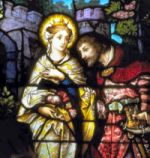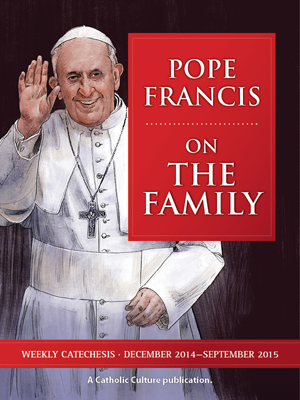Catholic Activity: Maundy Thursday and the Passover Meal
Maundy Thursday, or Holy Thursday in Holy Week marks the beginning of the Holy Triduum. Christians and Jews share this week as commemorating the Passover, but as Catholics we also commemorate the Paschal Meal, the Last Supper, during which Christ instituted the sacraments of Holy Orders and the Eucharist. Florence Berger discusses the richness of celebrating a paschal meal through a Christian's eyes.
DIRECTIONS
Whenever I hear Peter and John asking the Lord, "Where wilt Thou that we prepare the Pasch?" I want to interrupt and say, "Come to our house, please do." But even today we, as Catholics, can bring Christ and His friends home with us. When we receive the Holy Eucharist on Maundy Thursday, He lives within us. When we gather guests at our tables to re-enact the last supper, Christ is in our midst. For, as the antiphon of Holy Thursday sings, "where charity and love are, there is God." There is a divine bond between our altar and our home.
On the night of Holy Thursday, commemorate the Paschal meal as it was served in the time of Christ. If your family is not large, invite guests as the Jewish families did in obedience to God's command. The mother of the family first lights the festival candles and prays that "our home may be consecrated, Oh God, by the light of Thy countenance, shining upon us in blessing and bringing us peace." At the place of each guest is a small dish of salt water, a plate containing Matzo, green bitter herbs, and Haroses. Haroses is a strange combination of apples, raisins and cinnamon resembling apple butter; it was eaten to remind the Jews of their slave labor in the brickyards of the Egyptians. Before the father's place is a large bowl of wine because during the meal four different libations will be made.
After the blessing of the feast is given in a most beautiful prayer, the leader distributes the first cup of wine. Then he washes his hands. It was probably at this point that Christ washed the feet of His disciples. The green bitter herbs — wild lettuce, coriander, endive or chicory — are dipped in salt water and eaten as a memorial of the bitterness of Jewish slavery. Yet God is praised who gives us these fruits of the soil. Lastly, as a mark of charity and hospitality, Matzo, the bread of affliction, is given to all present with the words, "Let all who are hungry come and eat. Let all who are in want come and celebrate the Passover with us."
As the cadences of the ancient Jewish prayers sound out we seem to hear the Christian liturgy with new ears. There is an echo and a change. The old law has found its fulfillment in the new. A second cup of wine is poured, and then the story of the deliverance from Egypt is told as it is written in Exodus 12. At this point the Paschal lamb is brought in.
You cannot serve a whole lamb roasted on a crossed spit in a modern apartment, but you can have lamb. Perhaps some time you may be privileged to attend a larger gathering at a Pascal meal as we were at Grailville last year. When the Pesach, or Pascal lamb, was carried in, a quiver ran through the crowd. No bone was broken and the spit was two crossed sticks. It was as though a lamb had been crucified. All the references to Christ as Lamb of God came rushing into our consciousness. Never before had the prophesies cried so loud. Never before had the signs blazed so brilliantly. Never before had we realized how Jewish we Christians really are. Lamb of God, have mercy on us!
As the different symbolic dishes of the Paschal meal are explained to the oncoming generations, we begin to understand that food is more than mere meat for the body. As cooks, our occupation becomes spiritualized. As mothers, we become proud queens in our kitchens. As women, we become the nourishers of man's body and soul. God stooped to take bread and change it into His own Divine Person. With this visible act of love, He feeds and sustains us. So it is that love is expressed by the preparation and presentation of food. Do you see now why we need Christian cookbooks?
We, as Catholics, can sing again the Hallel psalms giving praise to God — not only for deliverance from Egypt, but from "slavery to freedom, from sorrow to joy, from mourning to festive day, from darkness to a great light and from subjection to redemption." The unleavened bread of affliction has become the Bread of Life of the adopted sons of God. The bitter herbs and Haroses have been discarded because Our Savior has come; our mouths are now filled with honey and sweetness. The fruit of the vine has been sanctified and has become the Bridegroom at the feast. "Give praise to the Lord, for He is good: And His mercy endureth forever."
Activity Source: Cooking for Christ by Florence Berger, National Catholic Rural Life Conference, 4625 Beaver Avenue, Des Moines, IA 50310, 1949, 1999






